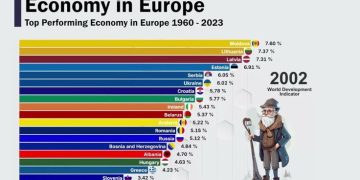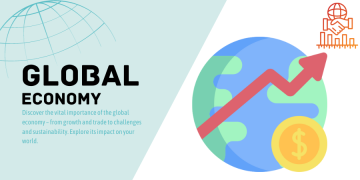Introduction
- Context and Importance of the Financial System:
- The financial system underpins the global economy, facilitating trade, investments, savings, and capital flows. It encompasses banks, markets, financial institutions, and payment systems, which operate as critical engines of economic growth.
- Over the past few decades, technology has steadily infiltrated the financial sector. With the rise of digital tools and platforms, there has been a growing conversation about how digital transformation could fundamentally alter financial markets, institutions, and services.
- Purpose of the Article:
- This article will explore how digital transformation could potentially revolutionize the global financial system, examining the benefits, challenges, and transformative effects of technology in financial services. It will analyze innovations such as blockchain, AI, fintech, digital currencies, and decentralized finance (DeFi), and how they might reshape the global economy.
Section 1: Understanding Digital Transformation in the Financial Sector
- Defining Digital Transformation:
- Digital transformation refers to the integration of digital technologies into all aspects of business, leading to fundamental changes in how industries operate and deliver value to customers. In the financial sector, it involves the use of technologies such as AI, cloud computing, blockchain, digital banking, and mobile apps.
- This section will define key elements of digital transformation in finance, including automation, data analytics, digital payment systems, and customer-centric digital experiences.
- The Historical Evolution of Financial Technology:
- Trace the history of technological advancements in finance, from the early days of electronic banking in the 1970s to the advent of the internet in the 1990s, and the rise of mobile payments in the 2000s.
- Highlight significant milestones such as the introduction of online banking, ATMs, and fintech startups, which have been pivotal in the digital evolution of the financial system.
Section 2: Key Digital Technologies Transforming the Financial Sector
- Blockchain and Cryptocurrencies:
- Explain blockchain technology, which provides a decentralized ledger system that records transactions across multiple computers in a secure and transparent way.
- Explore the rise of cryptocurrencies like Bitcoin, Ethereum, and others, and their role in disrupting traditional banking systems. Consider the implications of decentralized finance (DeFi) and how it challenges traditional financial intermediaries such as banks and insurance companies.
- Examine the potential for blockchain technology to streamline processes in areas such as payments, remittances, securities trading, and cross-border transactions.
- Artificial Intelligence (AI) and Machine Learning:
- Analyze how AI and machine learning are being employed to enhance decision-making, risk management, and customer service in the financial industry.
- Discuss the role of AI in credit scoring, fraud detection, personalized financial products, and algorithmic trading. Highlight how AI can increase efficiency, reduce costs, and improve financial outcomes for both individuals and businesses.
- Digital Payments and Mobile Banking:
- Detail the evolution of digital payments, focusing on mobile banking apps, contactless payments, peer-to-peer (P2P) transfer platforms (like Venmo, PayPal, and WeChat), and digital wallets (e.g., Apple Pay, Google Pay).
- Discuss how digital payment systems have facilitated financial inclusion, particularly in regions with low access to traditional banking infrastructure.
- Explore how these payment innovations are redefining how people and businesses conduct transactions on a global scale, offering speed, convenience, and lower costs.
- Cloud Computing:
- Discuss the role of cloud computing in enhancing financial services by providing scalable infrastructure, improving data storage, and offering high-performance computing at a reduced cost.
- Analyze how financial institutions use cloud technology for data management, customer analytics, and collaboration between institutions. Evaluate the benefits of cloud-based financial platforms in terms of cost savings, flexibility, and scalability.
- Regtech and Cybersecurity:
- Introduce the concept of regulatory technology (regtech), which helps financial institutions comply with regulations, monitor transactions, and manage risk using digital solutions.
- Discuss the growing importance of cybersecurity in the financial sector, considering how digital transformation increases the risk of cyber threats. Analyze how the industry is leveraging advanced encryption, AI-based threat detection, and blockchain to combat fraud and maintain secure systems.
Section 3: The Benefits of Digital Transformation for the Global Financial System
- Enhanced Efficiency and Cost Reduction:
- One of the most significant advantages of digital transformation is the potential for increased operational efficiency and cost savings. By automating tasks, streamlining workflows, and reducing human error, financial institutions can achieve faster, cheaper, and more accurate services.
- Examine specific examples where digital tools have reduced the cost of financial services (e.g., cheaper cross-border payments, lower transaction fees).
- Improved Financial Inclusion:
- Digital transformation holds the promise of bringing financial services to unbanked and underbanked populations, particularly in developing countries where access to traditional banking is limited.
- Explore the role of mobile money platforms like M-Pesa in Kenya, which provide millions of people with access to financial services through mobile phones, bypassing the need for physical bank branches.
- Consider how digital technologies enable microloans, insurance products, and savings plans tailored to low-income individuals, fostering economic inclusion.
- Better Customer Experience:
- As customer expectations evolve, digital transformation enables financial institutions to offer personalized services, greater transparency, and faster access to financial products and services.
- Discuss how AI and data analytics are enhancing customer experiences through customized offerings, real-time advice, and automated assistance via chatbots and robo-advisors.
- Increased Transparency and Trust:
- The transparency offered by technologies such as blockchain can help reduce fraud, ensure accuracy, and increase trust in financial transactions. Public blockchain ledgers make transactions more transparent and traceable.
- Evaluate how the increased transparency could improve regulatory oversight, reduce corruption, and increase consumer confidence in the financial system.
- Innovation in Financial Products and Services:
- Digital transformation fosters innovation in financial products and services. New technologies enable the creation of novel financial products, such as digital currencies, tokenized assets, and smart contracts, which allow for automated and secure transactions without intermediaries.
- Consider how fintech startups and traditional financial institutions are collaborating to create cutting-edge financial services, such as decentralized finance (DeFi) applications, algorithmic trading platforms, and robo-advisory services.

Section 4: The Challenges and Risks of Digital Transformation
- Regulatory Challenges and Risks:
- One of the biggest hurdles in the digital transformation of the financial system is the challenge of creating regulations that protect consumers and prevent financial crimes, while fostering innovation and competition.
- Examine the difficulties regulators face in adapting traditional financial regulations to new technologies such as cryptocurrencies, blockchain, and AI-driven trading.
- Discuss the potential for regulatory arbitrage, where businesses exploit gaps or inconsistencies in regulatory frameworks across jurisdictions.
- Cybersecurity and Data Privacy Risks:
- As financial institutions rely more heavily on digital technologies, they become increasingly vulnerable to cyberattacks, data breaches, and identity theft.
- Discuss the challenges of securing vast amounts of sensitive financial data stored on digital platforms and the role of cybersecurity measures in mitigating these risks.
- Evaluate how hackers and malicious actors could exploit weaknesses in digital financial systems and what measures are being taken to ensure security, such as encryption, multi-factor authentication, and AI-based threat detection systems.
- Digital Divide and Exclusion:
- While digital transformation offers significant opportunities, it may also exacerbate inequality. Those without access to smartphones, high-speed internet, or digital literacy may be excluded from the benefits of digital financial services.
- Explore the risk that digital transformation could deepen the gap between wealthy and low-income individuals or between countries that have access to digital infrastructure and those that do not.
- Displacement of Jobs and Skills Gap:
- The adoption of automation, AI, and digital processes in the financial sector could lead to job displacement, particularly in roles such as bank tellers, financial analysts, and customer service representatives.
- Examine how institutions are managing this transformation and upskilling employees to adapt to the changing landscape.
Section 5: Case Studies of Digital Transformation in the Financial Sector
- Fintech Revolution:
- Explore successful case studies of fintech companies that have disrupted traditional financial services. Examples include companies like Stripe, Square, and Robinhood, which have revolutionized payments, trading, and lending.
- Discuss how fintech startups leverage digital tools to offer innovative products that challenge traditional banks and financial institutions.
- Blockchain Adoption by Banks:
- Analyze the increasing adoption of blockchain by major banks and financial institutions. Examine examples like JPMorgan’s JPM Coin, which allows for faster and more secure cross-border payments, or the use of blockchain in securities trading by platforms like Ripple.
- Central Bank Digital Currencies (CBDCs):
- Discuss the rise of central bank digital currencies (CBDCs), which are digital forms of fiat currency issued by central banks. Examine countries like China with its digital yuan, and other nations exploring CBDCs as a way to improve the efficiency and stability of financial systems.
Section 6: The Future of Digital Transformation in Global Finance
- Technological Advancements on the Horizon:
- Explore emerging technologies that may further shape the future of global finance, such as quantum computing, 5G technology, and artificial intelligence. Consider how these innovations could disrupt existing financial systems and lead to entirely new forms of financial services.
- The Role of Digital Transformation in the Post-Pandemic World:
- Examine how the COVID-19 pandemic accelerated the adoption of digital financial services and how this shift may persist post-pandemic. Digital banking, e-commerce, and remote services have become more vital as consumers and businesses adapt to new norms.
- The Evolution of Financial Ecosystems:
- Discuss the future evolution of financial ecosystems, where traditional banks, fintech companies, and decentralized finance platforms coexist and collaborate to provide a more inclusive, efficient, and secure global financial system.
Conclusion
- Summary of Key Points:
- Recap the importance of digital transformation in revolutionizing the global financial system, highlighting the key technologies, benefits, and challenges discussed.
- The Future of the Financial System:
- Offer insights into how the global financial system may evolve with the continued integration of digital technologies, focusing on the potential for increased accessibility, efficiency, and security.
- Final Thoughts:
- Conclude by emphasizing the need for collaboration between governments, regulators, financial institutions, and technology developers to ensure that digital transformation is achieved responsibly, with consideration for privacy, security, and equity.





































